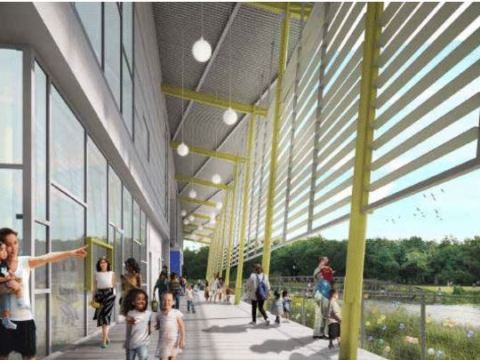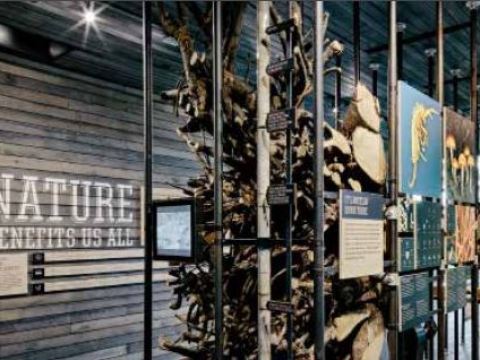
This article originally appeared in the July/August 2018 issue of Museum magazine.
Museums can use environmental performance to enhance mission and visitor experience.
Museums have long held a special place in the hierarchy of our communities. They are sources of local, regional, and national pride.
They remain trusted sources of information in an age when such trust is hard to come by. They are stewards of our collective histories and often serve as a mirror to our values and aspirations. However, many museums operate in an energy-intensive and ultimately unsustainable way due to operational challenges stemming from collection preservation requirements and other unique systems. Throughout the 20th century, building design and engineering has largely focused on maximizing comfort (through mechanical means) and minimizing construction costs (taking the quick and easy path) while paying little heed to environmental impacts, resource consumption, and long-term operating costs. The negative results of this predominant approach to our natural surroundings and climate are well documented—but the approach to design is changing slowly.
In 2000, the United States Green Building Council launched the Leadership in Energy and Environmental Design (LEED) rating system, which minimizes buildings’ environmental impact. LEED has quickly gone mainstream: as of October 2017, LEED buildings represented more than 6.2 billion square feet of certified commercial construction.
A few pioneering cultural institutions, such as the Grand Rapids Art Museum, were early LEED adopters, proving that museums could find creative ways to reduce their environmental footprint while maintaining best practices for care of collections.
While the collective impact of this green building movement has been significant, what more can we do to reverse these trends and create a truly sustain able built environment? Perhaps more important, how can museums serve as positive examples of a shift from a reductive attitude of minimizing negative impact toward a mindset of maximizing positive change?
Connecting Mission to Operations
If we connect the design of museum buildings and landscapes to their positive and forward-thinking mission statements, we can harness the story-telling strengths of museum professionals to ensure that sustainable designs have a lasting impact on visitors. This mindset moves beyond the “checklist” approach that rating systems such as LEED use to a more artful design process that includes intentional and thoughtful design decisions.

Every project, large or small, has its challenges and budget limitations, but this mission-focused design methodology can help focus the countless decisions that must be made to create a refined design with meaningful measures of sustainability.
The goal is to enhance the museum’s mission and interpretive opportunities, improve its environmental footprint, and reduce long-term operating costs. Following are three examples of museums that have recently sought to improve their environmental impact through design.
Louisiana Children’s Museum
In 2006, shortly after Hurricane Katrina, the leadership of the Louisiana Children’s Museum sought to reimagine the New Orleans-based museum. “The goal was to think holistically about how we design a building, grounds, exhibits, programs, partnerships, and family learning experiences—all to advance goals of sustainability and stewardship for our community,” says CEO Julia Bland. “This integrated planning approach has taken us on an amazing journey, and will ultimately give our youngest citizens and their families a broad variety of experiences that will help build a much more resilient community—while having a lot of fun together.”
Unlike the museum’s space in the Warehouse District, a new facility in New Orleans City Park, opening mid-2019, will have plenty of outdoor play and exhibit space.
Carefully sited at the edge of a lagoon and positioned to protect the nearby live oak trees, the new building and landscape create a series of choreographed visitor experiences. The project will restore and naturalize the shoreline of the man-made lagoon, which benefits local wildlife and provides a rich interpretive experience.
The project site, however, is not without its challenges.
Hurricane Katrina left CityPark under several feet of standing water, so to protect critical building systems against any future severe weather events, the building will be constructed on structural piers approximately five feet above the existing water line.
Another design challenge involved meeting stringent new city criteria to store a significant amount of stormwater on site. Rather than building a costly detention vault underground, the landscape includes a series of bioretention planting beds to absorb the stormwater like a sponge. The plantings do double duty, enhancing the beauty of the site and the visitor experience while also filtering contaminants from the parking areas before the water reaches the lagoon.
Other sustainable features include a large south-facing brise-soleil that shades the building facade and Welcome Porch, and a radiant floor design that provides cooling while enhancing energy performance. In addition, a rainwater harvesting system captures rain from roof surfaces to be used for outdoor water play.
Nordic Museum
Linking mission to design was also a key strategy for Seattle’s Nordic Museum, which had outgrown its original location in a former school building. The new facility embodies Nordic design in its simplicity and efficiency while keeping its sustainability visually understated.
Climate control is an environmental challenge for many museums since properly storing and exhibiting art and artifacts can be an energy-intensive practice. In the original project requirements for the new Nordic Museum building, the entire facility was to meet American Society of Heating, Refrigerating and Air-Conditioning Engineers (ASHRAE) Class A criteria for temperature and humidity controls, which establishes a very limited range of variability in the indoor atmosphere. While this approach is ideal for the preservation of sensitive objects, it also significantly increases energy consumption and long-term operating costs.
As the architects and engineers worked with museum staff, it became apparent that many items on display in the museum’s collections could easily tolerate wider variability in temperature and humidity. This meant that most of the facility could be designed to meet ASHRAE Class C levels, while retaining Class A levels in select areas, like the collection storage areas and the temporary gallery.
Sensitive artifacts displayed outside these areas are exhibited in climate-controlled vitrines to properly ensure their safekeeping.
This approach has resulted in energy savings that well exceed the Seattle Energy Code’s strict requirements—a remarkable achievement for a collection-based museum—as well as reduced construction and operating costs. The museum is now able to receive sensitive artifacts on loan from other museums, including those from Nordic countries—an opportunity that had not been possible in the original facility because it did not meet many institutions’ minimum requirements for borrowing objects.
Sustainability Treehouse
In contrast to the Nordic Museum’s understated approach, the Sustainability Treehouse wears its eponymous mission on its sleeve. Designed for the Boy Scouts of America at the site of its National Jamboree in West Virginia, the Sustainability Treehouse seeks to capture the wonder of childhood adventure while encouraging environmental stewardship. The Treehouse includes a series of exhibit galleries and environmental interpretive experiences stacked vertically into the surrounding tree canopy.
The original design evolved from a one-story environmental education center to a multi-story treehouse to minimize the facility’s footprint and preserve the site’s many beautiful trees. It also harvests all the energy and water resources it needs through renewable energy systems and rainwater capture—one of the ways the design is targeted to meet the Living Building Challenge, one of the most rigorous standards of sustainable design. (See “What Is the Living Building Challenge?” sidebar for more information on this standard.)

Where Do We Go from Here?
As our society continues its gradual shift to a more sustainable future, museums can help lead the way.
Each capital project—whether large or small, new or renovation—can advance a museum’s mission and improve its environmental impact, while enhancing visitor experience and staff well-being.
For example, selecting low-emitting materials and paints improves the overall indoor air quality and better protects collections. Upgrading dated mechanical and electrical systems can save significant money over time, which can be redirected toward programming. Landscapes can be crafted to interpret ethnobotanical topics while improving local water quality and reducing heat-island effects.
It is an exciting time for the design and construction industry; we are on the precipice of a significant shift toward a more environmentally friendly built environment. Using the momentum LEED established, new rating systems, like the Living Building Challenge and the WELL Building Standard, are propelling the industry forward, redefining what it means to be truly sustainable and advancing human health and well-being in the built environment.
Ultimately, we can design the future we want for our organizations and society as a whole. Through their high profiles and respected stature in our communities, museums are uniquely positioned to be leaders in this positive change. A thoughtful approach to design can unify mission, building, and site to create a powerful visitor experience. Each project is a golden opportunity for a museum to artfully enhance its natural surroundings, improve its environmental footprint, and physically embody what it truly values.
What Is the Living Building Challenge?
Managed by the International Living Future Institute, the Living Building Challenge asks, “What if every single act of design and construction made the world a better place?”
The Living Building Challenge simplifies the intent of many LEED credits but goes further by requiring facilities to be net-zero energy and water, among other rigorous requirements.
In addition, the Living Building Challenge includes a material “red list,” a prohibition on the use of materials containing chemicals known to be harmful to building occupants and the environment. It also takes the unique step of requiring projects to be “beautiful” in order to enhance human comfort and delight, but also because we will better protect and care for facilities we love—extending their lifespans long into the future.
Sustainability Considerations
Whether your institution is considering a new building or a renovation, here are some things to consider as you start the project.
- When exploring options for new mechanical systems, consider performing a life-cycle cost analysis to determine long-term operating costs versus initial construction costs. Often the payback period is relatively short over the long lifespan of a museum facility.
- Use the entire site to enhance the visitor experience by designing landscapes that are both beautiful and conducive to interpretive opportunities. Landscaping can also enhance water quality and storm water control.
- Select interior materials and paints with low or zero VOCs (volatile organic compounds). VOCs have harmful long-term effects on human health and possibly collections.
- Take advantage of capital campaigns to prioritize funding for building system upgrades, which will enhance energy and water performance while reducing long-term operational costs.








Comments